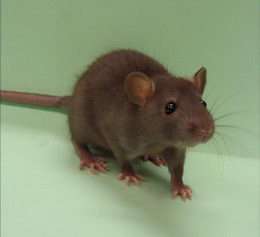MIT researcher explains how rats think

After running a maze, rats mentally replay their actions - but backward, like a film played in reverse, a researcher at the Picower Institute for Learning and Memory at MIT reports Feb. 12 in the advance online edition of Nature.
In 2001, Matthew A. Wilson, a professor in the Department of Brain and Cognitive Sciences, reported that animals have complex dreams and are able to retain and recall long sequences of events while asleep. Like people, rats go through multiple stages of sleep, from slow-wave sleep to REM sleep.
Slow-wave sleep, also referred to as non-REM sleep, makes up a large fraction of the normal sleep cycle and occurs earlier than REM sleep. REM sleep, which takes its name from the rapid eye movements that occur during this type of sleep, is associated with dreaming.
Wilson found that during slow-wave sleep, animals replayed spatial experiences in the same order they were experienced.
His latest results show that, following a spatial experience such as running laps on a track, the awake animal replays the memory so precisely that its recorded brain activity corresponds exactly to the places it has just been. However, to the researchers' surprise, the episode is replayed in time-reverse order, with the most recent locations first, proceeding sequentially back to the beginning of the task.
This backward instant replay may play a significant role in reinforcing learning, Wilson said. "Understanding this replay is likely to be critical in understanding how animals - and humans - learn from experience. This phenomenon may constitute a general mechanism of learning and memory."
The hippocampus, a seahorse-shaped brain structure in the temporal lobe, has long been known to be involved in spatial navigational learning in rodents, as well as in the ability of rodents, primates and humans to remember events.
Wilson and MIT postdoctoral fellow David J. Foster measured the activity of cells in the rat hippocampus during periods of running and stopping. During each session, each animal ran several laps on familiar and unfamiliar tracks, occasionally stopping for a food reward. After eating, the animal paused to groom its fur, move its whiskers or just stand still before running again. It was during this pause that the reverse replay occurred, and it was most likely to occur when an animal ran an unfamiliar track, supporting the idea that this phenomenon helps the hippocampus reinforce a newly learned task.
While running, the animal's hippocampal cells fired in order, corresponding with the animal's position on the track. When the animal stopped, many of the same cells fired again, but the sequence of cell activation was in reverse order and spanned the entire track. This replay was literally instant - it took less than a second to replay up to 30 seconds of running.
Wilson says that the ability to eavesdrop on both the sleeping and conscious brain could be a valuable tool in treating memory disorders such as amnesia or Alzheimer's disease, or it may prove helpful in finding ways for people to learn and memorize information more effectively.
Source: MIT
















